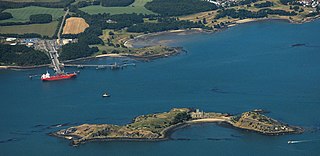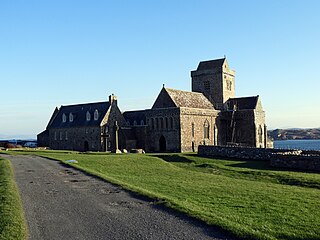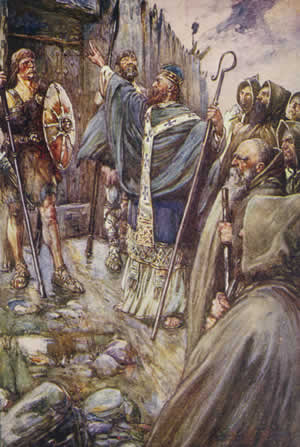
Inchcolm Abbey is a medieval abbey located on the island of Inchcolm in the Firth of Forth in Scotland. The Abbey, which is located at the centre of the island, was founded in the 12th century during the episcopate of Gregoir, Bishop of Dunkeld. Later tradition placed it even earlier, in the reign of King Alexander I of Scotland (1107–24), who had taken shelter on Incholm when his ship was forced ashore during a storm in 1123. It is said he resided there for three days with the Hermit of Incholm.

Inchcolm is an island in the Firth of Forth in Scotland. It was repeatedly attacked by English raiders during the Wars of Scottish Independence, and was fortified during both World Wars to defend nearby Edinburgh. Inchcolm now attracts visitors to its former Augustine Abbey.
The Bishop of Dunkeld is the ecclesiastical head of the Diocese of Dunkeld, one of the largest and more important of Scotland's 13 medieval bishoprics, whose first recorded bishop is an early 12th-century cleric named Cormac. However, the first known abbot dates to the 10th century, and it is often assumed that in Scotland in the period before the 12th century, the roles of both bishop and abbot were one and the same. The Bishopric of Dunkeld ceased to exist as a Catholic institution after the Scottish Reformation but continued as a royal institution into the 17th century. The diocese was restored by Pope Leo XIII on 4 March 1878; it is now based in the city of Dundee.

The Diocese of Bath and Wells is a diocese in the Church of England Province of Canterbury in England.

Iona Abbey is an abbey located on the island of Iona, just off the Isle of Mull on the West Coast of Scotland.

The Abbot of Iona was the head of Iona Abbey during the Middle Ages and the leader of the monastic community of Iona, as well as the overlord of scores of monasteries in both Scotland and Ireland, including Durrow, Kells and, until the Synod of Whitby, Lindisfarne. It was one of the most prestigious clerical positions in Dark Age Europe, and was visited by kings and bishops of the Picts, Franks and English. The Ionan abbots also had the status of Comarba of Colum Cille, i.e. the successors of that Saint, Columba.

The Bishops' Conference of Scotland (BCOS), under the trust of the Catholic National Endowment Trust, and based in Airdrie, North Lanarkshire, is an episcopal conference for archbishops and bishops of the Roman Catholic Church in Scotland. The conference is primarily made up of the presiding bishops of Scotland's eight dioceses as well as bishops who have retired.
John Scotus was a 12th-century bishop of St. Andrews and Dunkeld.
Hugh the Chaplain was the royal Chaplain of King William I of Scotland before becoming Bishop of Cell Rígmonaid (St Andrews), the highest ranking Scottish see of the period. After the death of Bishop Richard, King William selected Hugh to succeed to the bishopric in 1178. However, unbeknown to the king, the chapter elected their archdeacon, John l'Escot, as bishop. The king saw to Hugh's election and consecration in the same year. There followed a five-year struggle for the bishopric. John travelled to appeal to Pope Alexander III, who quashed the case of Hugh and sent to Scotland a man named Alexius as legate. Alexius obtained entrance to William's kingdom, and consecrated John at Holyrood Abbey in the presence of four other Scottish bishops, in the year 1180. Nevertheless, the struggle continued, and in 1183, both John and Hugh resigned their rights. Despite the fact that Hugh received the bishopric and John took the Bishopric of Dunkeld in compensation, dispute over revenues continued. When Hugh refused to answer his summons to Rome in 1186, he was suspended and excommunicated, with the diocese being put under interdict. Hugh travelled to Rome and obtained absolution, but he died of the pestilence in that city a few days later.
Richard was a 12th-century bishop of Dunkeld. He got the bishopric of Dunkeld, the second most prestigious bishopric in Scotland-north-of-the-Forth, after serving the King of Scots. He was capellanus Regis Willelmi, that is, chaplain of King William I of Scotland, and had probably been the chaplain to William during the reign of King Malcolm IV. He was consecrated at St Andrews on 10 August 1170, by Richard, former chaplain of King Malcolm IV but now the bishop of St Andrews. Richard continued to have a close relationship with King William I, and was in Normandy with the king in December 1174 when the Treaty of Falaise was signed.
Richard de Inverkeithing was a 13th-century cleric from Scotland, probably from Inverkeithing in Fife. He was a Chamberlain of King Alexander II of Scotland and Bishop of Dunkeld.
William the Dean was a 13th-century bishop of Dunkeld. He had been a dean of the diocese of Dunkeld, and was elected to the bishopric when news of the death of bishop-elect Hugo de Strivelin arrived from Rome. William soon travelled to Continental Europe for his consecration, and on the orders of the pope, was consecrated by Cardinal Ordonius, bishop of Tusculum. All of this happened by 13 December 1283, when it is related in a letter of Pope Martin IV. Unusually for bishops of Dunkeld, very little is known of his episcopate. The only thing that is known that he did after consecration was visit the shrine of Saint Cuthbert at Durham in 1285. As his successor Matthew de Crambeth is confirmed as bishop of Dunkeld in April 1288, it can be presumed that Bishop William died in either late 1287 or early 1288.
The Abbot of Inchcolm, or until 1235, the Prior of Inchcolm, was the head of the Augustinian monastic community of Inchcolm.

St Stephen's Church is a Church of England parish church in St Albans, Hertfordshire, England. It is located to the south of the town centre, at the top of St Stephen's Hill. It is a Grade II* listed building.
The Abbot of Holyrood was the head of the Augustinian monastic community of Holyrood Abbey, now in Edinburgh. The long history of the abbey came to a formal end in July 1606 when the parliament of Scotland turned the abbey into a secular lordship for the last commendator, John Bothwell. The following is a list of abbots and commendators:
James Livingston was a 15th-century cleric from East Lothian in south-eastern Scotland. Born at an unknown date in the 15th century, he was a son of the Laird of Saltcoats. He chose a career in the church, and became rector of the churches of Forteviot and Weme, and vicar of Innerleithen. By 1474, if not earlier, he had become dean for the whole diocese of Dunkeld. After the death of Thomas Lauder, Livingston was chosen as his successor as Bishop of Dunkeld. Although Livingston's appointment was contested at Rome by Thomas Spens, Bishop of Aberdeen, who wanted to be translated to Dunkeld, Livingston was consecrated on 30 June 1476. Livingston's episcopate is relatively obscure; he spent a good deal of time in Edinburgh, where he is witness to several charters. He died at Edinburgh, on 28 August 1483. He was buried in Inchcolm.
George Brown was a late 15th-century and early 16th-century Scottish churchman. He first appears on record in 1478 as the rector of the church of Tyningham, and is called a clerk of the diocese of Brechin. In 1482, he was selected to be Chancellor of the diocese of Aberdeen.

The Diocese of Dunkeld is a diocese of the Latin Church of the Catholic Church in southern Scotland. On 28 December 2022, the Diocese became sede vacante following the resignation of Bishop Stephen Robson due to ill health.

The Diocese of Aberdeen is a diocese of the Latin Church of the Catholic Church in Scotland.









